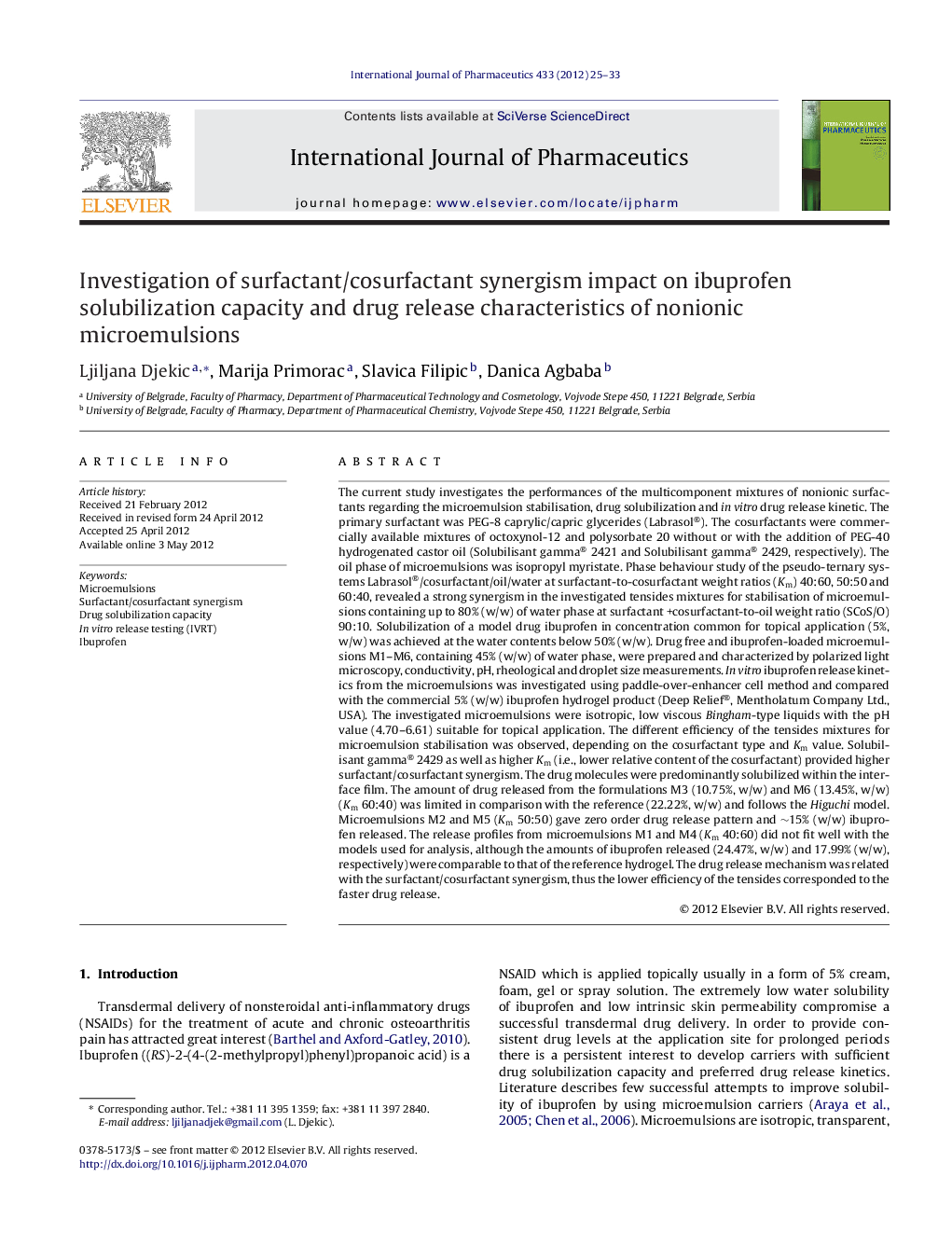| کد مقاله | کد نشریه | سال انتشار | مقاله انگلیسی | نسخه تمام متن |
|---|---|---|---|---|
| 2502900 | 1557403 | 2012 | 9 صفحه PDF | دانلود رایگان |

The current study investigates the performances of the multicomponent mixtures of nonionic surfactants regarding the microemulsion stabilisation, drug solubilization and in vitro drug release kinetic. The primary surfactant was PEG-8 caprylic/capric glycerides (Labrasol®). The cosurfactants were commercially available mixtures of octoxynol-12 and polysorbate 20 without or with the addition of PEG-40 hydrogenated castor oil (Solubilisant gamma® 2421 and Solubilisant gamma® 2429, respectively). The oil phase of microemulsions was isopropyl myristate. Phase behaviour study of the pseudo-ternary systems Labrasol®/cosurfactant/oil/water at surfactant-to-cosurfactant weight ratios (Km) 40:60, 50:50 and 60:40, revealed a strong synergism in the investigated tensides mixtures for stabilisation of microemulsions containing up to 80% (w/w) of water phase at surfactant +cosurfactant-to-oil weight ratio (SCoS/O) 90:10. Solubilization of a model drug ibuprofen in concentration common for topical application (5%, w/w) was achieved at the water contents below 50% (w/w). Drug free and ibuprofen-loaded microemulsions M1–M6, containing 45% (w/w) of water phase, were prepared and characterized by polarized light microscopy, conductivity, pH, rheological and droplet size measurements. In vitro ibuprofen release kinetics from the microemulsions was investigated using paddle-over-enhancer cell method and compared with the commercial 5% (w/w) ibuprofen hydrogel product (Deep Relief®, Mentholatum Company Ltd., USA). The investigated microemulsions were isotropic, low viscous Bingham-type liquids with the pH value (4.70–6.61) suitable for topical application. The different efficiency of the tensides mixtures for microemulsion stabilisation was observed, depending on the cosurfactant type and Km value. Solubilisant gamma® 2429 as well as higher Km (i.e., lower relative content of the cosurfactant) provided higher surfactant/cosurfactant synergism. The drug molecules were predominantly solubilized within the interface film. The amount of drug released from the formulations M3 (10.75%, w/w) and M6 (13.45%, w/w) (Km 60:40) was limited in comparison with the reference (22.22%, w/w) and follows the Higuchi model. Microemulsions M2 and M5 (Km 50:50) gave zero order drug release pattern and ∼15% (w/w) ibuprofen released. The release profiles from microemulsions M1 and M4 (Km 40:60) did not fit well with the models used for analysis, although the amounts of ibuprofen released (24.47%, w/w) and 17.99% (w/w), respectively) were comparable to that of the reference hydrogel. The drug release mechanism was related with the surfactant/cosurfactant synergism, thus the lower efficiency of the tensides corresponded to the faster drug release.
The synergism in multicomponent mixtures of nonionic tensides observed in Labrasol®-based microemulsions affects the mechanism and in vitro release profile of ibuprofen solubilized at the oil/water interface.Figure optionsDownload high-quality image (188 K)Download as PowerPoint slide
Journal: International Journal of Pharmaceutics - Volume 433, Issues 1–2, 20 August 2012, Pages 25–33